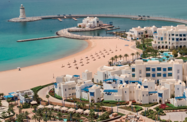Qatar’s tourism sector will be one of the big winners of the 2022 FIFA World Cup, with an accelerated building programme of hotels, hospitality facilities and entertainment centres aimed at making sure fans will enjoy their stay, though care has to be taken to ensure that once the World Cup is over, visitors keep coming through the turnstiles.
Even before winning the rights to host the 2022 World Cup, Qatar had been working hard to put in place the infrastructure to support a large-scale tourism industry. Some of these developments include an international airport that will be able to process 50m passengers a year and a planned proposal to build a terminal to handle cruise liners.
The finishing touches have been put to the $1.2bn Qatar National Convention Centre, which has already begun staging events ahead of its formal opening before the end of the year, strengthening the country’s appeal as a business and congress destination. The centre hosted the World Innovation Summit for Education last month and is planning to host the 20th World Petroleum Congress in December. In total, Qatar expects around $25bn to be invested over the coming 11 years in tourism-related projects, according to information compiled by the Qatar Tourism Authority (QTA).
While much of this investment is still to come, Qatar’s tourism sector is already expanding, despite regional unrest and concerns over the global economy. The country has posted solid growth in 2011 while many nations in the region have seen arrival numbers slump or only marginally increase. According to data issued by the UN World Tourism Organisation (UNTWO) at the end of October, incoming tourism numbers are forecast to increase by between 4% and 5% over the next 12 months — a significant contrast to the drop in visitor numbers across the Middle East, where the agency says there has been an 11% decline.
Indeed, it is possible that Qatar benefitted from the instability in some parts of the Middle East and North Africa. In the first six months of 2011, there was a 39.1% jump in the number of visitors from other GCC states, visitors who may have chosen to stay closer to home rather than travel to other countries in the region that were embroiled in political unrest.
Data issued by the QTA also showed that the first half of 2011 saw a steady rise in hotel occupancy rates, with 63% of beds occupied nightly, up from 61% for the same period in 2010. Additionally, overall arrival numbers climbed 3.12%. Though visitor numbers and occupancy rates peaked in February, coinciding with Qatar hosting the Asian Football Cup, the drop off following the final whistle was negligible, according to the QTA.
This could be significant for Qatar’s tourism aspirations deep into the next decade and beyond. While the country is pinning much of its medium-term hopes on the 2022 World Cup and the surge of visitors the event will undoubtedly bring, in the longer term Qatar must be able to maintain the momentum it generates in the lead up to football’s premier tournament. To do so, Qatar will need to expand the range of tourism activities it has to offer and hone those already up and running.
The expected growth in tourist arrivals has prompted a flurry of building activity, with QTA data showing 77 new hotels and a further 42 hotel apartments under construction as of mid-2011. Of these, 25 hotels and 10 hotel apartments are scheduled to be completed by the end of 2011, adding just under 6400 rooms to current availability. In total, it is estimated that some 5000 hotel rooms will come on line every year up until the 2022 World Cup kicks off.
Hoss Vetry, the cluster general manager for the Ritz Carlton Doha, said it was critical that Qatar avoided oversaturation in the sector. “At the end of the day, customers have so many places to travel to, and Doha for the last two years has become a new destination for people who want to look for new places, but my recommendation is that we don’t make the same – I don’t want to use the word mistake – of allowing so many hotels to be built, and then later on you don’t have enough travellers coming in,” he said in an interview with the Gulf Times in mid-October.
It was important to strike a balance between the needs of a one-off event such as the World Cup, and a longer-term vision for the economy and tourism, Vetry said. Qatar should be able to do that with ease, however, seeing as how it already hosts several annual events, including the Qatar Masters Golf Tournament, Qatar Open, ExxonMobil Open Championship, Qatar Cycling Tour and the Asia Football Cup of Nations.
Ahmed Abdullah Al Nuaimi, the chairman of the QTA, is confident the industry will pass easily through any post-World Cup doldrums. In an interview with Reuters earlier this year, Al Nuaimi said the tourism sector would target the 50m passengers flowing through the new international airport.
“If we just attract 5% of the airport capacity, that’s about 2.5m a year. That’s going to be great business,” he said in mid-August.
Though it will be a long time before Qatar has a clear impression of how well its tourism industry will adapt to life after the World Cup, the sector will be well-equipped to meet visitors’ needs. The challenge will be to ensure it cashes in on the publicity and goodwill a successful staging of the event will provide.

